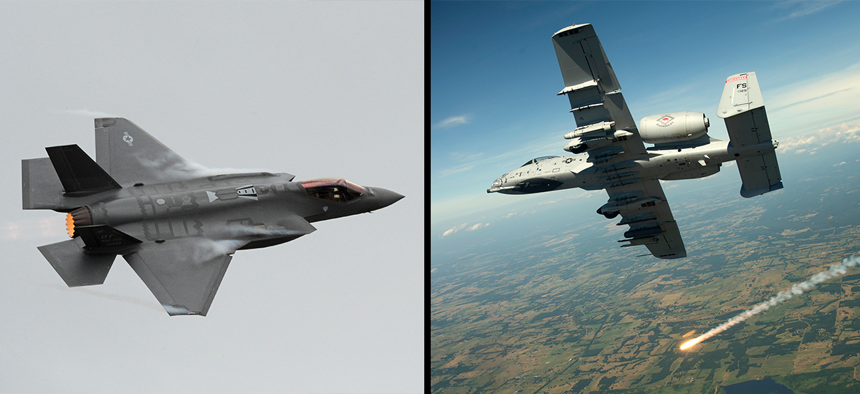
The Air Force Will Test the F-35 Against the A-10—But Not Until 2018
Is the Warthog better at defending ground troops? The brass wants to know, not that they're in any rush.
If you’re the Pentagon, how do you choose between an aging, but dependable, fighter jet and a brand new aircraft that you’re not quite sure is up to the job? You have them fight it out, naturally.
That’s essentially what the Air Force said it would do when it announced that starting in 2018, it would pit the A-10 “Warthog” against the F-35 Joint Strike Fighter in a series of tests to see if the new F-35s can adequately replace the A-10s, which the military wants to retire. A 40-year-old platform, the A-10 has been described by Martin Dempsey, the joint chiefs chairman, as “the ugliest, most beautiful aircraft on the planet.” It may be old, but as a certain Irish actor would say, it has a very particular set of skills: The A-10 excels at providing what’s known as “close-air support,” flying low and slow to provide ideal cover protection for U.S. troops fighting in ground combat. That capability is prized not only by the military, but also by a pair of key Republican lawmakers who oversee its budget, Senators John McCain and Kelly Ayotte.
The $400 billion F-35 program has been maligned for its production delays and unprecedented expense, and while the snazzy (and stealthy) new joint strike fighters are expected to be able to do many things well once they’re fully ready around 2021, there’s concern that they won’t be able to match the A-10’s close-air support capability. McCain, who heads the Senate Armed Services Committee, and Ayotte have been campaigning to get the Defense Department to drop its plans to retire the A-10 by 2019 to save money, in large part because of those worries. As a result, the Pentagon is setting up a “comparison evaluation” to see if the F-35 can measure up. “You can’t guess at what the capability gaps are,” J. Michael Gilmore, head of the Pentagon’s testing operation, told reporters at the Pentagon. “It’s really not wise to guess. You have to go out and get data and do a thorough and rigorous evaluation.”
The House and Senate both insisted on fully funding the A-10 as part of the annual defense authorization bill this year, and Ayotte reacted skeptically to news that the Pentagon would test the two aircraft. “I will not support the divestment of the A-10 until an equally or more capable close air support aircraft achieves full operational capability,” she said in a statement:
If the Air Force’s position is that the F-35A will ultimately replace the A-10’s close air support mission, it is entirely appropriate and necessary to conduct realistic and rigorous comparison testing to determine whether the F-35A delivers on all facets of the CAS mission before divesting the A-10.
On the other hand, if the Air Force’s position is that the F-35A will not cover some parts of the A-10’s CAS mission, the onus is on the Air Force to tell Congress and our ground troops what platform will meet those close air support requirements.
McCain spokesman Dustin Walker echoed those concerns. “Comparison tests on the close-air support mission will be an important step in assessing the capability of the F-35,” he said. “However, serious concerns remain about the Air Force’s capacity to perform the close-air support mission with the oldest and smallest fleet in its history, and when less than half of its fighter squadrons are completely combat ready.”
(See also: The F-35 Won’t Be Going To War Against ISIS Just Yet)
The F-35 is not going away, of course. As James Fallows wrote in his cover feature last year, the program is “a triumph of political engineering.” McCain and Ayotte have supported it publicly. Unlike other disputes between Congress and the Pentagon over a major defense program, their support for the A-10 doesn’t appear tied to parochial concerns, like the loss of a base or jobs in their state; they aren’t advocating for producing new planes, just to keep the current ones in service.
An added concern for lawmakers is timing. The Pentagon has said that it plans to finish phasing out the A-10 by 2019, but the F-35s won’t be completely ready until 2021. McCain and Ayotte say they haven’t received adequate answers on what the military will do if the U.S. is engaged in ground combat overseas within that gap. (Both Republicans, incidentally, have said that a more aggressive and prolonged U.S. military campaign against ISIS is needed.) Gilmore told reporters that other aircraft could be included in the close-air support testing as well. Given the political loyalty to the aging A-10, the Pentagon’s battle of the fighter jets could be aimed at proving the F-35’s capability to Congress—as much as to itself.